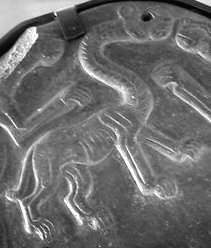Snake neck panther
| Snake neck panther in hieroglyphics | ||||
|---|---|---|---|---|
|
Pictorial representation of a serpent-neck panther |
||||
Sedja / Sudja S (w) D3 The (the sun) moves / The (the sun) can be safely |
||||
| Serpentine panther on the four-dog pallet (detail) | ||||
|
Cylinder seal from Uruk : snake dragon, depiction from around 3000 BC. Chr. ( Louvre ) |
||||
Serpentine panther (also Serpopard ; ancient Egyptian Sedja, Sudja ) is the name of a mythical mythical creature that is attested in Mesopotamia , Elam and in ancient Egypt . In ancient oriental studies it is usually referred to as a snake dragon .
While Wolfgang Helck suspects the influence of stamp seal motifs from Elam behind the figure of the serpent-neck panther , Wolfram Nagel assumes a Mesopotamian cultural transfer. In ancient Egyptian mythology , the serpentine neck panthers on the palettes of the predynastic era were also an integral part of the pictorial programs.
Representations
Characteristic of snake-necked panthers are their long necks, which are modeled on those of giraffes . The body is that of a panther . On many pallets, the beings have their long necks wrapped around one another.
The snake neck panthers are even kept on a leash on the Narmer pallet . Their embrace should possibly represent the union of the two kingdoms of Egypt ( Upper and Lower Egypt ).
In another representation on the two-dog palette , two snake-necked panthers can be seen as they are probably entwined around a solar disk . Both of their heads strike a gazelle in an attempt to kill it. A Ba soul bird hovers over this scene .
Two ivory sickles come from Hierakonpolis , on which a man, as an “animal tamer”, “tames” two serpent-necked panthers. This motif could be borrowed from the Sumerian or Mesopotamian culture and as a
|
Mythological connections
Whitney Davis and Wolfgang Helck suspect that snake-necked panthers as monsters of the desert should represent chaos and elemental force, especially since the desert has always been considered hostile and threatening.
Wolfhart Westendorf refers to the old mythical idea that the snake-necked panther moves the sun on its daily path, or that the snake-necked panther was considered to be the " bearer of the sun ". According to Elmar Edel, the ancient Egyptian name is therefore directly related to his role.
Partial aspects of the motif of the snake-necked panther killing a gazelle in connection with the sun's eye are the content of the demotic fable The Seer and the Listener . In addition, the act of killing shows a further reference to the contents of the Nutbuch and the mythical process “lion kills bull / gazelle”, which deals with the subject of the daily rebirth of the sun god.
In coffin texts from the Middle Kingdom , the role of the serpent-neck panther in ancient Egyptian cosmology is defined accordingly as the support of the sky and the guardian of the sun god Re .
After Re was elevated to the position of the highest heavenly deity and the mythological foundations changed in the further course of ancient Egyptian history, sphinx monuments replaced the serpentine panthers as guardians with regard to the panther symbol and now flanked the path to the entrance gates of the Duat . In the corridors of the mortuary temples , on the other hand, the giraffes took on the function of serpentine panthers.
literature
- Whitney Davis : Masking the Blow: The Scene of Representation in Late Prehistoric Egyptian Art . Berkeley, Oxford (Los Angeles) 1992, ISBN 0-5200-7488-2 .
- Whitney Davis, Richard W. Quinn: Replications: archeology, art history, psychoanalysis . Penn State Press, Copenhagen 1996, ISBN 0-2710-1524-1 .
- Elmar Edel : Ancient Egyptian Grammar (series: Analecta orientalia, No. 39) . Pontificium Inst.Biblicum, Rome 1964, § 442.
- Wolfgang Helck : Investigations on the Thinite Age (= Ägyptologische Abhandlungen. (ÄA) Vol. 45). Harrassowitz, Wiesbaden 1987, ISBN 3-447-02677-4 .
- Wolfgang Helck: snake neck panther . In: Wolfgang Helck, Eberhard Otto : Lexicon of Egyptology, Vol. 5: Building pyramids - stone vessels . Harrassowitz, Wiesbaden 1984, ISBN 3-447-02489-5 , Sp. 652-653.
- Wolfhart Westendorf : snake neck panther (mythological) . In: Wolfgang Helck, Eberhard Otto: Lexicon of Egyptology. Vol. 5: Building a pyramid - stone vessels. Harrassowitz, Wiesbaden 1984, ISBN 3-447-02489-5 , Sp. 653.
- Reinhard Dittmann , Christian Eder, Bruno Jacobs (Ed.): Ancient Studies in Dialog. Festschrift for Wolfram Nagel on the completion of his 80th year of life . Ugarit-Verlag, Münster 2003, ISBN 3934628419 .
Web links
Individual evidence
- ↑ a b Wolfgang Helck: Schlangenhalspanther . Sp. 652-653.
- ↑ a b Wolfhart Westendorf: Schlangenhalspanther (mythological) . Sp. 653.
- ↑ Mesopotamian serpent dragon .
- ^ Reinhard Dittmann, Christian Eder , Bruno Jacobs (eds.): Ancient Studies in Dialog. P. 217.
- ↑ Representation of two serpent-necked panthers killing a gazelle (above is the Ba soul bird, below you can see how an animal is grasped with claws) .
- ↑ Qjs ; ancient egyptian qusae
- ↑ Wolfgang Helck: Investigations on the thinite age . Pp. 135-137.


